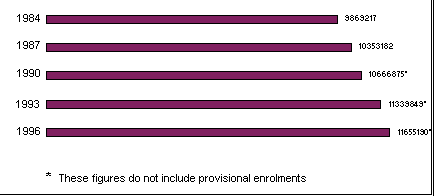Australian Electoral Commission


The electoral roll is a list of all people who are registered to vote at Australian elections. You cannot vote at an election unless your name is on the electoral roll. Australian citizens over 18 years of age (with a few exceptions) must enrol to vote. Seventeen year olds may provisionally enrol and will be able to vote if their 18th birthday falls on or before polling day.
The only non-Australian citizens eligible to vote at federal elections in Australia are British subjects who were on a Commonwealth electoral roll immediately before 26 January 1984, at which time the eligibility requirements were altered.
The following people are not entitled to enrol and vote:
Enrolment cards are available at all post offices and agencies and AEC offices. They may be returned to the AEC by post, fax or in person.
For the 1996 federal election there were 11 655 190 people enrolled to vote at the close of rolls on 5 February 1996 (this included 8 302 provisionally enrolled electors who turned 18 between the close of rolls and polling day):
| State | 1996 |
|---|---|
| NSW | 3 926 293 |
| VIC | 2 954 596 |
| QLD | 2 082 451 |
| WA | 1 077 647 |
| SA | 989 885 |
| TAS | 325 750 |
| ACT | 200 828 |
| NT | 97 740 |
| AUSTRALIA | 11 655 190* |
* Close of rolls figures were calculated following the processing of all enrolment cards received by 8pm on 5 February 1996 and appear only on this page. All other enrolment figures in this publication are close of rolls figures which have been adjusted since polling day to give the exact number of electors entitled to vote at the election. The adjustments include the removal of the names of electors who died after the close of rolls and the reinstatement of eligible electors previously removed from the roll.
Comparative close of rolls enrolment figures for federal elections conducted since 1984 are presented below.

Some people qualify for special enrolment which provides them with special services related to their needs:
| Provisional | Itinerant | Overseas | Silent | Antarctic | |
|---|---|---|---|---|---|
| NSW | 10882 | 442 | 1097 | 3656 | 43 |
| VIC | 5464 | 533 | 1109 | 3175 | 61 |
| QLD | 2381 | 432 | 402 | 2105 | 29 |
| WA | 2281 | 201 | 134 | 1827 | 24 |
| SA | 2319 | 197 | 86 | 1894 | 26 |
| TAS | 164 | 59 | 52 | 177 | 89 |
| ACT | 702 | 44 | 1129 | 519 | 18 |
| NT | 243 | 44 | 78 | 107 | 6 |
| TOTAL | 24436 | 1952 | 4087 | 13460 | 296 |
After the close of rolls, extracts of data from the computerised roll management system are used to produce Certified Lists of electors, reference rolls and microfiche.
The Certified List is the official electoral roll used on polling day to mark off electors' names. It contains name and address details of all electors. Two black arrow head markings (clockmarks), about a centimetre apart are found beside the name of each elector. At the polling place the polling official draws a line between the arrow heads indicating that the elector has been given ballot papers. After an election the Certified Lists are electronically scanned to identify apparent non-voters and possible multiple voters.
For the 1996 election:
Reference rolls are also produced following the close of rolls for an election. They contain the same information as Certified Lists without the clockmarks and are produced specifically as reference material. Under the CEA all candidates contesting an election are provided with copies of the roll for the division or State or Territory in which they are standing. Reference rolls are also available for public inspection at the relevant Divisional Office.
For this election:
The roll was also produced on microfiche and made available for public inspection at all AEC offices.